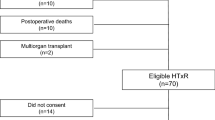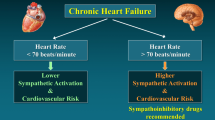Abstract
The cardiovascular, catecholamine, and nitrate/nitrite (NOx) responses to bicycle exercise were measured in 14 normal subjects (controls) and two groups with sympathetic denervation; 14 with peripheral autonomic failure (pure autonomic failure [PAF]); and 13 with central autonomic failure (multiple system atrophy [MSA]).
With exercise, blood pressure increased in control subjects by 40±7/24±5 mm Hg (p<0.001) and fell in PAF by 24±8/24±5 mm Hg (p<0.02 and p<0.007) and MSA by 31±7/11±3 mm Hg (p<0.005 and p<0.04). With exercise, the increase in heart rate was greater in control subjects (60±3 to 111±4/min; p<0.0001) than in PAF (69±3 to 86±4/min; p<0.0001) and MSA (70±4 to 90±4; p<0.001).
Resting plasma noradrenaline levels were similar in controls (291±51 pg ml−1) and MSA (257±49 pg ml−1), but lower in PAF (82±14 pg ml−1). With exercise, plasma noradrenaline increased in controls but was unchanged in PAF and MSA. Resting NOx was similar in controls (50±5 nmol/L; range, 23.3–87.6 nmol/L) and PAF patients (59±8 nmol/l; range, 19.3–116.4 nmol/L), but was higher in MSA patients (87±14 nmol/L; p<0.025, range 15.4–157.2 nmol/L). With exercise, NOx was unchanged in control subjects and increased by 10% and 17% in PAF and MSA, respectively; these changes were not statistically significant.
This study suggests that circulating changes in NOx levels do not exert a major role in exercise-induced hypotension in subjects with sympathetic denervation.
Similar content being viewed by others
References
Granger HJ, Goodman AH, Granger DN. Role of resistance and exchange vessels in local microvascular control of skeletal muscle oxygenation in the dog.Circulation Res 1976; 38:379–385.
Goonewardene IP, Karim F. Attenuation of exercise vasodilation by adenosine deaminase in anesthetizwd dogs.J Physiol 1991; 442:65–79.
Persson MG, Ohlen A, Lindbom L, Hedqvist P, Gustafsson LE. Role of adenosine in functional hyperemia in skeletal muscle as indicated by pharmacological tools.Naunyn Schmiedebergs Arch Pharmacol 1991; 343:52–57.
Kilbom A, Wennmalm A. Endogenous postaglandins as local regulators of blood flow in man: effect of indomethacin on reactive and functional hyperemia.J Physiol 1976; 257:109–121.
Wilson JR, Kapoor SC. Contribution of prostaglandins to exercise-induced vasodilation in humans.Am J Physiol 1993; 265:H171-H175.
Duncker DJ, Van Zon NS, Altman JD, Pavek TJ, Bache RJ. Role of K+ ATP channels in coronary vasodilation during exercise.Circulation 1993; 88:1245–1253.
Palmer RMJ, Ferrige AG, Moncada S. Nitric oxide release accounts for the biological activity of endothelium-derived relaxing factor.Nature 1987; 327:524–526.
Palmer RMJ, Ashton DS, Moncada S. Vascular endothelial cells synthesize nitric oxide from L-arginine.Nature 1988; 333:664–666.
Furchgott RF, Zawadzki JV. The obligatory role of the endothelial cells in the relaxation of arterial smooth muscle by acetylcholine.Nature 1980; 288:373–376.
Cocks TM, Angus JA. Endothelium dependent relaxation of coronary arteries by noradrenaline and serotonin.Nature (London) 1983; 305:627–630.
Pohl U, Holtz J, Busse R, Bassenge E. Crucial role of endothelium in the vasodilator response to increased flowin vivo.Hypertension 1986; 8:37:37–44.
Rubanyi GM, Romero JC, Vanhoutte PM. Flow-induced release of endothelium-derived relaxing factor.Am J Physiol 1986; 250:H1145-H1149.
Vallance P, Collier J, Moncada S. Effects of endothelium-derived nitric oxide on peripheral arteriolar tone in man.Lancet 1989; ii:997–1000.
Wilson JR, Kapoor S. Contribution of endothelium derived relaxing factor to exercise induced vasodilation in humans.J Appl Physiol 1993; 75:2740–2744.
Gilligan DM, Panza JA, Kilcoyne CM, Waclaawiw MA, Casino PR, Quyyumi AA. Contribution of endothelium-derived nitric oxide to exercise-induced vasodilation.Circulation 1994; 90:2853–2858.
Tagawa T, Imaizumi T, Endo T, Shiramoto M, Harasawa Y, Takeshita A. Role of nitric oxide in reactive hyperemia in human forearm vessels.Circulation 1994; 90:2285–2290.
Endo T, Imaizumi T, Tagawa T, Shiramoto M, Ando S, Takeshita A. Role of Nitric Oxide in Exercise-Induced Vasodilation of the Forearm.Circulation 1994; 90:2886–2980.
Persson MG, Gustafsson LE, Wilklund NP, Hedqvist P, Moncada S. Endogenous nitric oxide as a modulator of rabbit skeletal muscle microcirculationin vivo.Br J Pharmacol 1990; 100:463–466.
Mathias CJ. Disorders of the Autonomic Nervous System. In:Neurology in Clinical Practise. 2nd Edition. Bradley WG, Daroff RB, Fenichel GM, Marsden CD, eds. Butterworth-Heinemann; Boston: 1996; 82:1953–81.
Mathias CJ, Bannister R. Investigation of autonomic disorders. In:Autonomic Failure: A Textbook of Clinical Disorders of the Autonomic Nervous System, 4th edn. Edited by Bannister R, Mathias CJ. Oxford: Oxford University Press; 1999:169–195.
Smith GDP, Watson LP, Pavitt DV, Mathias CJ. Abnormal cardiovascular and catecholamine responses to supine exercise in human subjects with sympathetic dysfunction.J Physiol 1995; 485:255–265.
May C, Ham IW, Heslop K, Stone FA, Mathias CJ. Intravenous morphine causes hypotension, hypoglycaemia and increases sympatho-adrenal activity in the conscious rabbit.Clin Sci 1988; 75:71–77.
Giovannoni G, and Land JM, Keir G, Thompson EJ, Heales SJR. Adaptation of the nitrate reductase and Griess reaction methods for the measurement of serum nitrate and nitrite.Ann Clin Biochem 1997; 34:193–198.
Marshall RJ, Schirger A, Shepherd JT. Blood pressure during supine exercise in idiopathic orthostatic hypotension.Circulation 1961; 24:76–81.
Bevegard S, Jonsson B, Karlof I. Circulatory response to recumbent exercise and head-up tilting in patients with disturbed sympathetic cardiovascular control (postural hypotension).Acta Medica Scandinavia 1962; 172:623–636.
Granger DL, Miller WC, Hibbs JB. Methods of analyzing nitric oxide production in the immune response. In:Methods in Nitric Oxide Research. Feelisch M, Stamler JS, eds. Chichester: John Wiley & Sons; 1996:603–617.
Beckman JS, Beckman TW, Chen J, Marshall PA, Freeman BA. Apparent hydroxyl radical production by peroxynitrite: implications for endothelial injury from nitric oxide and superoxide.Proc Natl Acad Sci USA 1990; 87:1620–1624.
Langrehr JM, Hoffman RA, Lancaster JR, Simmons RL. Nitric oxide—a new endogenous immunomodulator.Transplantation 1993; 55:1205–1212.
Egberts J, Soederhuizen W. Urine samples before dinner are preferable when studying changes in endogenous nitrate production under uncontrolled dietary conditions.Clin Chim Acta 1996; 254:141–148.
Yamabe H, Okumura K, Ishizaka H, Tsuchiya T, Yasue H. Role of endothelium-derived nitric oxide in myocardial reactive hyperemia.Am J Physiol 1992; 263:H8-H14.
Polinsky RJ. Neuropharmacological investigation of autonomic failure. In:Autonomic Failure: a Textbook of Clinical Disorders of the Autonomic Nervous System, 4th edn. Bannister R, Mathias C, eds. 1999:232–244.
Vallance P, Collier J, Moncada S. Nitric oxide synthesised from L-arginine mediates endothelium-dependent dilatation in human veins.Cardiovasc Res 1989; 23:1053–1057.
Moncada S, Palmer RMJ and Higgs EA. Nitric oxide: physiology, pathophysiology and pharmacology.Pharmacol Rev 1991; 43:109–142.
Author information
Authors and Affiliations
Corresponding author
Rights and permissions
About this article
Cite this article
Akinola, A.B., Land, J.M., Mathias, C.J. et al. Contribution of nitric oxide to exercise-induced hypotension in human sympathetic denervation. Clinical Autonomic Research 9, 263–269 (1999). https://doi.org/10.1007/BF02319456
Received:
Accepted:
Published:
Issue Date:
DOI: https://doi.org/10.1007/BF02319456




